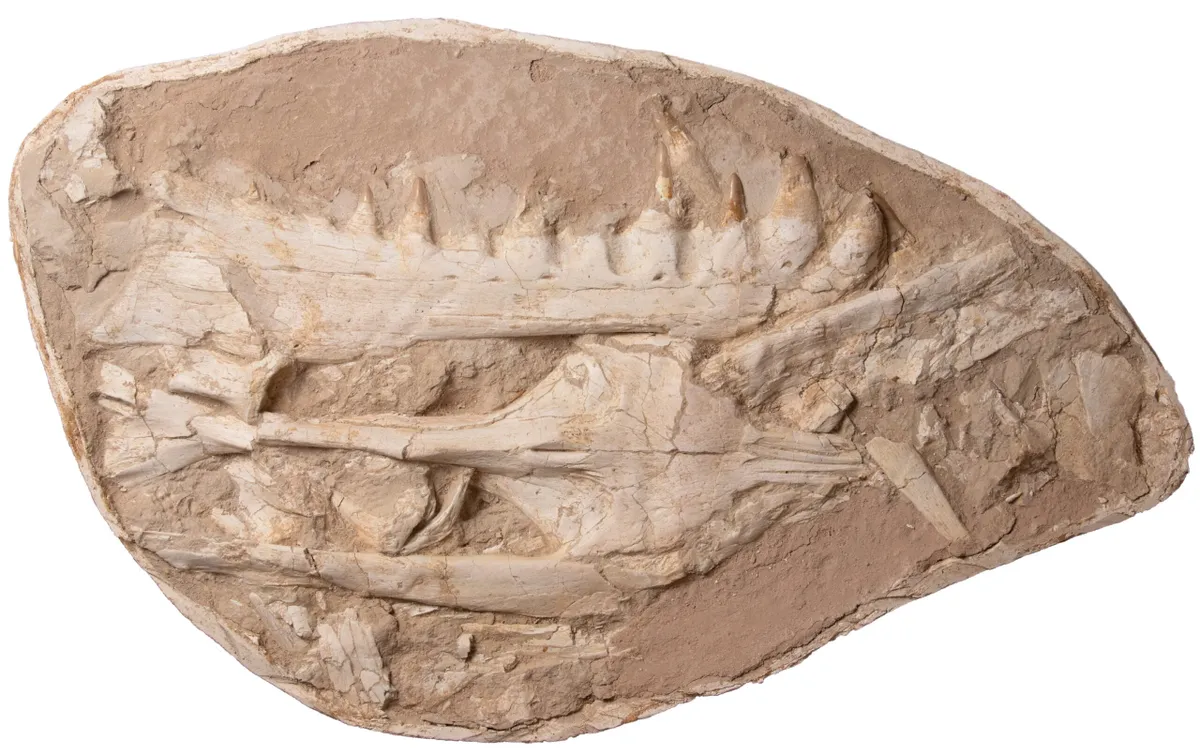Paleontologists have discovered the fossilised remains of an enormous sea lizard in a phosphate mine south-east of Casablanca in Morroco. Their findings, published in Cretaceous Research, suggest that our oceans were once far more preditor-rich than they are today.
According to the study, which analysed the skull and parts of the skeleton, Khinjaria acuta was 7-8 metres long – roughly the size of an orca – and had extremely powerful jaws with teeth like daggers.
It lived 66 million years ago, alongside Tyrannosaurus and Triceratops, but it wasn't a dinosaur. Instead, this huge species of predatory marine lizard was a member of the family Mosasauridae, or mosasaurs, which are relatives of today’s Komodo dragons and anacondas.
Khinjaria acuta was one of many predators to inhabit the Atlantic Ocean off the coast of Morocco during the Cretaceous Period.
- Megalodon: the super-shark that could swallow killer whales whole but didn't like the cold
- Giant pre-historic worms discovered in Greenland

The study, which involved researchers from the University of Bath in the UK and the Marrakech Museum of Natural History, among others, suggests that the world's oceans were dramatically different ecosystems 66 million years ago compared to what we see today, with numerous apex predators hunting and eating large prey. In contrast, modern ecosystems have reletively few apex predators – the great white shark and orca are two examples.
“What’s remarkable here is the sheer diversity of top predators,” says Dr Nick Longrich of the Department of Life Sciences and the Milner Centre for Evolution at the University of Bath, who led the study.
“Some mosasaurs had teeth to pierce prey, others to cut, tear or crush. Now we have Khinjaria, with a short face full of huge, dagger-shaped teeth." Dr Nick Longrich
“We have multiple species growing larger than a great white shark, and they’re top predators, but they all have different teeth, suggesting they’re hunting in different ways.
“Some mosasaurs had teeth to pierce prey, others to cut, tear or crush. Now we have Khinjaria, with a short face full of huge, dagger-shaped teeth. This is one of the most diverse marine faunas seen anywhere, at any time in history, and it existed just before the marine reptiles and the dinosaurs went extinct.”

Morocco’s diverse marine reptiles lived just before a large asteroid crashed into Earth 66 million years ago, causing the fifth mass extinction event. Dust and fine particles filled the atmosphere, blocking out the sun and thrusting the world into darkness. It was the end for the dinosaurs on land – and the same happened in the oceans.
Mosasaurs, among other giants of the ocean, disappeared, replaced by whales, seals and fish. However, the ecosystem that evolved after the impact was different.

“There seems to have been a huge change in the ecosystem structure in the past 66 million years,” says Longrich.
“This incredible diversity of top predators in the Late Cretaceous is unusual, and we don’t see that in modern marine communities.”
Modern marine food chains have just a few large apex predators, animals such as orcas, white sharks and leopard seals. Meanwhile, the Cretaceous Period had a vast number of top predators.
“It’s not just that we’re getting rid of the old actors and recasting new ones into the same roles. The story has changed dramatically," adds Longrich.
“Modern ecosystems have predators like baleen whales and dolphins that eat small prey, and not many things eating large prey. The Cretaceous has a huge number of marine reptile species that take large prey. Whether there’s something about marine reptiles that caused the ecosystem to be different, or the prey, or perhaps the environment, we don’t know. But this was an incredibly dangerous time to be a fish, a sea turtle, or even a marine reptile.”

Professor Nathalie Bardet, from the NMNH, says: “The Phosphates of Morocco deposit in a shallow and warm epicontinental sea, under a system of upwellings; these zones are caused by currents of deep, cold, nutrient-rich waters rising towards the surface, providing food for large numbers of sea creatures and, as a result, supporting a lot of predators. This is probably one of the explanations for this extraordinary paleobiodiversity observed in Morocco at the end of the Cretaceous.”
“The phosphates of Morocco immerse us in the Upper Cretaceous seas during the latest geological times of the dinosaurs’ age. No deposit has provided so many fossils and so many species from this period”, said Professor NE. Jalil of NMNH. “After the ’titan of the seas’, Thalassotitan, the ‘saw-toothed’ mosasaur Xenodens, the ‘star-toothed’ mosasaur, Stelladens and many others, now there is Khinjaria, a new mosasaur with dagger-like teeth.
“The elongation of the posterior part of the skull which accommodated the jaw musculature suggests a terrible biting force.”
Main illustration: Khinjaria acuta. Credit: Andrey Atuchin
